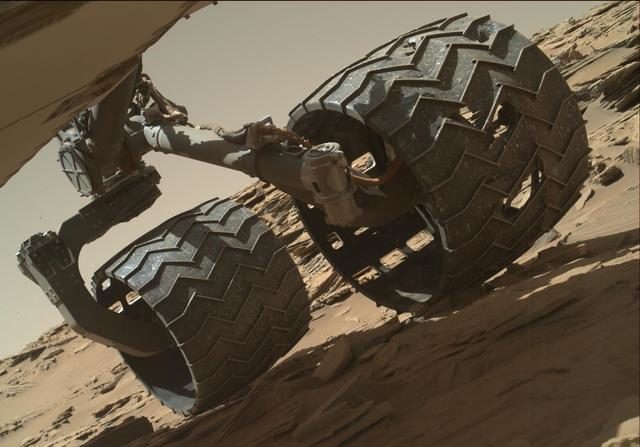Mission Update: Activities on Sols 3932-3933 Involve Rapid Progress
Curiosity Rover Continues to Explore Mars: New Discoveries Await
The Curiosity Rover continues its mission on Mars, undeterred by the challenges it faces. On Sol 3932-3933, the rover successfully navigated difficult terrains and made progress towards its planned ascent route up Mount Sharp. With another drive planned for Sol 3934, the rover is on the move towards an intriguing area with alternating light and dark layers.
Before embarking on the next journey, the rover’s geologists took advantage of the time available to gather valuable data on the surrounding rocks and strata. Curiosity’s arm will be used to investigate the composition and texture of a well-layered bedrock block named “Paion” using APXS and MAHLI instruments. Another bedrock target called “Amygdalea” will be analyzed using ChemCam, while Mastcam will capture images for documentation.
In addition to these targeted observations, Mastcam will also capture images of the possible contact between the Gediz Vallis ridge deposit and the underlying bedrock. The rover will observe a dark float named “Psofida” and study dust in the atmosphere. ChemCam will capture a long distance mosaic of the Gale crater rim and Peace Vallis fan before the atmosphere becomes too dusty.
Once the rover completes its drive, it will engage in a number of untargeted observations. CCAM will autonomously select a target for composition analysis using LIBS, Navcam will survey dust devils, and MARDI will capture images of the new terrain beneath the rover. Standard activities from REMS, DAN, and RAD will also be carried out.
Curiosity has been exploring Mars for 11 years and shows no signs of slowing down. As it continues to gather data and make new discoveries, scientists eagerly await what lies ahead.
In a previous update on Sol 3928-3930, Curiosity faced challenges in reaching the Gediz Vallis ridge. However, the rover finally arrived at its destination and is determined to maximize its scientific investigations before moving on.
The decision was made to forgo a usual drive in order to fit in more science activities while still at the upper Gediz Vallis ridge waypoint. The team wants to ensure that all desired data is collected before leaving the area for good.
Before determining the contact science targets, the team had to decide whether to drive or stay at the current location. Opting against a longer drive that could risk slipping on sandy terrain, they chose a smaller “bump” to examine nearby rocks.
Although the pre-selected target for Dust Removal Tool (DRT) was found to be incompatible, the team still managed to conduct APXS and MAHLI observations of “Epidaurus” and MAHLI imaging of “Limni Stymfalia.” Mastcam and ChemCam LIBS will further analyze these targets. ChemCam RMI will continue imaging Peace Vallis, while Mastcam documents a bedrock target selected by ChemCam AEGIS.
After the short drive, ENV will carry out various observations, including measuring cloud altitude above Gale using Zenith Movie and Cloud Shadow Movie, capturing a south-facing Suprahorizon Movie, and conducting a 360-degree dust devil survey. GEO will assist with planning by imaging the area in front of the rover, and AEGIS will autonomously select targets for ChemCam LIBS. Routine observations from REMS, RAD, and DAN will also be conducted.
Curiosity Rover’s mission on Mars continues to provide valuable insights into the Red Planet’s geology and atmospheric conditions. As it explores new areas and conducts further investigations, scientists anticipate exciting discoveries on the horizon.






